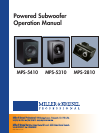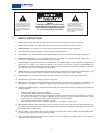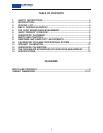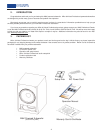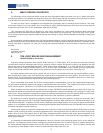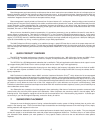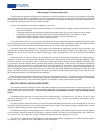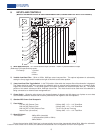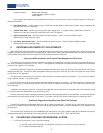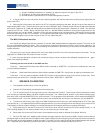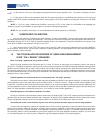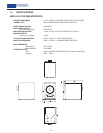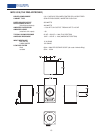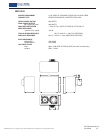
c.) A small, flat bladed screwdriver (or “tweeker”) to adjust the channel trim pots on the LFE-4.
d.) A CD player, or DVD player that can play CD-R’s.
e.) An M&K speaker system with the LFE-4 Bass Management Controller.
2. It may be helpful to have one person sit at the listening position and read the meter while another person adjusts the trim
pots on the LFE-4.
3. When the slot of the channel trim pots on the LFE-4 are pointing straight up and down, the gain of each of the channels is
approximately 0dB or unity. The trim pots have a plus or minus 12dB gain range. Rotating the pot counter-clockwise will attenuate
the channel a maximum of –12dB and rotating the pot clockwise will boost the channel gain a maximum of +12dB. The maximum
output of the LFE-4 is + 27dBu. With a nominal signal level of + 4dB with 20dB of headroom, the maximum signal level from the
source (console, etc.) can be + 24dB. Therefore, at very high signal levels you can only add around + 3dB of gain with the trim pots
before the signal chain of the LFE-4 overloads. If you need more than 3dB of gain at high signal levels, it is better to increase the
output of power amplifiers and use the trim pots on the LFE-4 to reduce the gain.
The M&K Professional test disc
Ken Kreisel has designed this test disc expressly for use with M&K satelite/subwoofer loudspeaker systems. The tones on this
disc are all bandwidth-limited Pink noise. This is to avoid room anomalies and therefore provide a more accurate calibration. By
using this disc with a Radio Shack SPL meter and following the instructions in this manual, you can achieve a remarkably accurate
system calibration.
The goal here is not to find an absolute SPL level, but to balance the SPL level of all channels relative to each other. For this
application, the Radio Shack SPL meter will work very well.
If a more accurate calibration is desired, we recommend using a real time analyzer with calibrated microphones and appro-
priate room analyzing software.
Following are the tones found on the M&K test disc:
Track one: Band limited Pink Noise from 500Hz to 3kHz recorded at –20dB FSD. Use this tone to calibrate your main and
surround (satellite) speakers.
Track two: Band limited Pink noise from 40Hz to 80Hz recorded at -20dB FSD. Use this tone to adjust your subwoofer level.
Track three: 1 kHz sine wave recorded at –20dB FSD. Use this to set the reference level of your source (console, etc.) On an
analog console this will be 0VU. On digital sources this will be either –20dB FSD or –18dB FSD.
11. SPEAKER CALIBRATION
1. Your speakers should now be in their final positions.
2. Remove all EQ and signal processing from the monitor path.
3. Turn all volume controls in the signal chain to their “reference level” position. These volume controls include the console
main monitor pot, submaster faders and power amplifier volume pots. The “reference level” position is your defined reference play-
back level, which is typically 85dB SPL for film, video and music. For the purposes of this discussion, we will assume that 85dB SPL
is your reference level. If you use a different reference level, then substitute the level that you use whenever you see 85dB SPL.
4. Transfer one channel only (left or right) of the M&K Professional test CD onto your audio storage medium (Pro Tools, open
reel recorder, etc.). It is important that the tones be played back from your source through the normal routing of your console or Pro
Tools system so that the system calibration is conducted through the same signal path that your audio goes through.
5. Select track three on the test CD and use the 1kHz tone to level-set your console for 0VU on an analog console, or –18
FSD if working digitally. Do not move the faders once you have level-set your monitor path.
6. Select track one on the test CD and route it to the speaker that you want to calibrate (for example: left front).
7. Set your SPL meter for C weighting (flat) and slow (average) response. Set the scale to 80dB. Hold the meter at about a
45 degree angle to vertical and at arm’s length to avoid a false reading from sound bouncing off your body and into the microphone.
Point the meter at the center speaker at about ear height. Play track one of the test CD through the selected speaker and read the
SPL. Adjust the level to 85dB using a small screw driver on the trim pot on the selected channel of the LFE-4.
10



